Thousands are working to recover after the damage left behind by Hurricane Idalia’s landing. Among those impacted are Florida and Georgia farmers, who are figuring out how to recover from crop damages left in the hurricane’s wake.
Idalia made landfall in Florida as a Category 3 hurricane on Aug. 30 in Florida, with wind speeds up to 125 miles per hour. The hurricane moved quickly into Georgia as a Category 2, creating strong winds and heavy rainfall across much of Southern Georgia.
Idalia leaves Florida poultry industry reeling
In Florida, the counts of dead livestock are steadily rising, with poultry farms hit especially hard. So far, 5 million chickens have been reported dead in the wake of the hurricane’s damage.
“It hit ag terribly bad,” Sammy Starling, a Dowling Park, Florida, farmer, told the Tallahassee Democrat. “It’s messed crops up. It’s messed up chicken houses. People have dead chickens all over the place, live chickens out of the barns.”
Lary Sessions, Live Oak, Florida’s city manager, estimates that an untold number of chickens will still likely have to be euthanized.

Thousands of acres of peanuts could also be lost due to the lack of power and infrastructure. With nowhere to take the nuts to dry and sell them, it’s likely the crop will spoil in fields.
Other crops damaged in Florida include citrus, corn, cotton, horticulture, nuts, fruit crops, and more. Florida Commissioner of Agriculture Wilton Simpson sent a letter to U.S. Secretary of Agriculture Tom Vilsack highlighting the catastrophic damage Florida’s agriculture industry suffered.
Hurricane Idalia hits Georgia’s pecan farms
The heavy wind and rain impacted 13,000 agriculture businesses and farms in Georgia. The hurricane left behind sweet corn laid down in the field, hay barns and facilities torn down, pivots damaged, and livestock operations running on generators while awaiting power reconnection, while two poultry houses are dealing with massive flooding.
Georgia Gov. Brian Kemp requested a federal disaster declaration for 30 Georgia counties impacted by the storms. One of the governor’s priorities includes helping farmers recover from the storms.
The Georgia Department of Agriculture also says it is working overtime with state and federal partners to provide resources to help farmers recover from the storm. But it will take weeks or even months to understand the full scope of the damage.
“As a seventh-generation farmer, I know firsthand the devastating impacts severe weather can have not only on our farmers and producers but on rural communities, local economies, and our state’s economy as a whole,” says Agriculture Commissioner Tyler Harper.
Meanwhile, thousands of acres of pecan and peach trees were leveled by hurricane winds. So far, 50 to 60 percent of this year’s pecan crop are considered a loss.
Aside from the loss of pecan crops in the largest pecan-producing state in the nation, the hurricane devastated and leveled trees on the farms. Reports of downed trees through Lowndes, Echols, Cook, Brooks, Pierce, Wilcox, Irwin, Ben Hill, and Crisp counties have already come in, and there may be more to come.
Tree losses will impact outputs on the farms for years to come because they cannot simply be replanted and harvested next year — replanted trees will take 15 to 20 years to reach peak production.
One Jefferson County farmer reported that hundreds of trees are knocked down and scattered across his 200-acre farm. Owner Buck Paulk of Shiloh Farms told WALBNEWS10 that 10,000 pecan trees were wiped out during the storm, accounting for 1,500 to 1,700 pounds per acre of lost production.
“We were really going into the prime age of that orchard, it’s hard to swallow,” Paulk told the news station.


